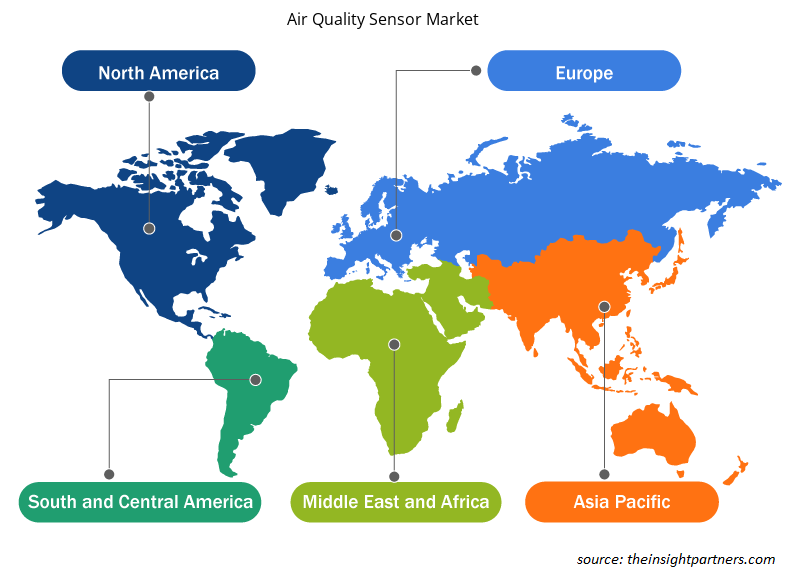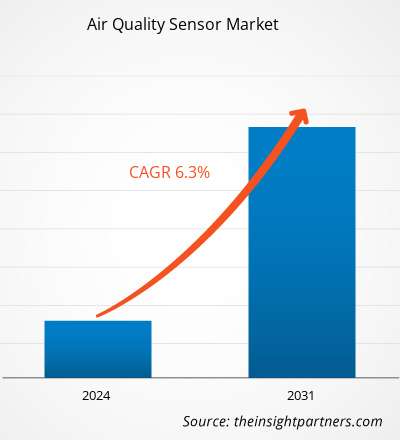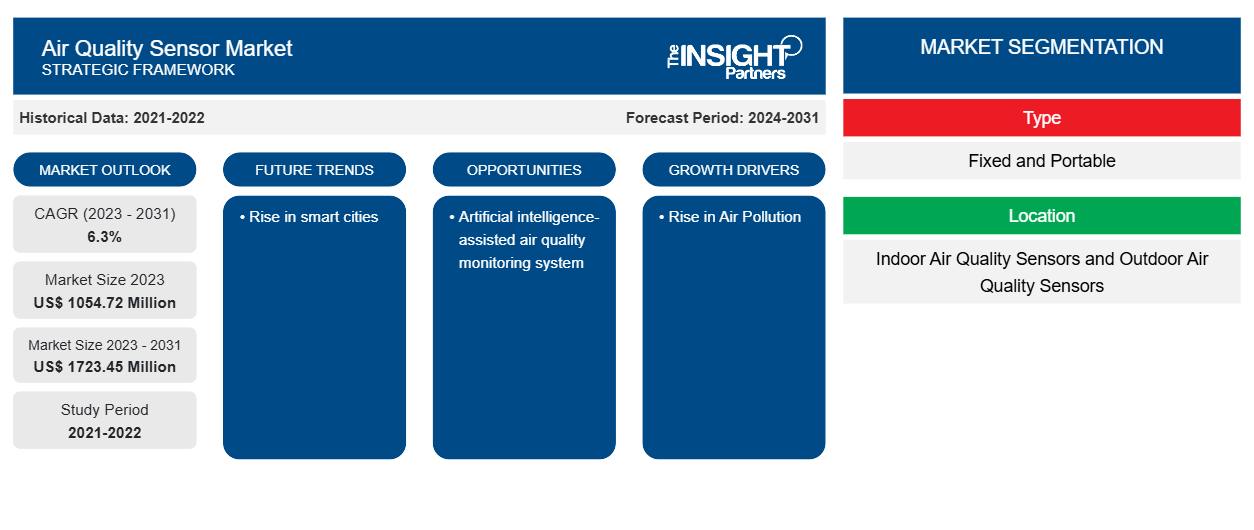空气质量传感器市场规模预计将从 2023 年的 10.5472 亿美元增至 2031 年的 17.2345 亿美元。预计 2023-2031 年市场复合年增长率将达到 6.3%。日益严重的空气污染和政府对可持续发展的关注可能仍是空气质量传感器市场的主要趋势。
空气质量传感器市场分析
日益增长的环境问题和政府对空气质量监测的严格规定推动了空气质量传感器市场的普及。人们越来越意识到清洁空气的重要性和空气传播疾病的弊端,这推动了各行各业对其的采用。政府对发展环保产业的举措进一步促进了其市场的增长。
空气质量传感器市场概览
空气质量传感器是一种测量空气中污染物浓度的设备,是空气净化器和新风系统必不可少的部件。空气质量传感器通常可以测量颗粒物(如pm1、pm2.5、pm10)、气体(如臭氧、一氧化碳、二氧化碳、甲烷、甲醛等)和一些环境指标(如温度、湿度、紫外线、照度等)。空气质量传感器利用光学、电学、热学等方法检测空气中的气体和颗粒物指标。
定制此报告以满足您的需求
您可以免费定制任何报告,包括本报告的部分内容、国家级分析、Excel 数据包,以及为初创企业和大学提供优惠和折扣
-
获取此报告的关键市场趋势。这个免费样品将包括数据分析,从市场趋势到估计和预测。
空气质量传感器市场驱动因素和机遇
空气污染加剧利好市场
随着工业化的发展,空气污染也随之增加,颗粒物等毒素也随之增加。一些国家的政府在各自的地区实施了严格的法规,并制定了各种措施来减轻来自工业场所的空气污染。此外,包括美国、印度和加拿大在内的许多国家的政府在发电厂、石油和天然气以及汽车中安装了空气质量传感器,以管理和跟踪污染水平。通过使用室外空气质量监测,工厂可以通过关注工业单位周围的空气质量指数来控制其排放率。
空气质量传感器的好处
随着全球对环境问题的日益关注,需要持续监测空气质量,以采取某些措施将其对环境的影响降至最低。因此,由于空气质量传感技术具有多种优势,其需求正在日益增长。它有助于通过实时监测室内/室外空气状况来创造健康的环境。空气质量传感器易于安装,可轻松连接到手机和计算机,并在其中显示空气质量结果。它可以检测温度、气压、湿度等多种参数。随着技术的不断进步,这些传感器的准确性正在提高,从而受到政府机构和学术机构、商业和住宅用户、石化工业、发电厂、制药业、智慧城市当局等众多行业的众多参与者的需求。因此,为了满足这一需求,市场参与者推出了推动空气质量传感器市场的解决方案。例如,2021 年 6 月,维萨拉推出了一款世界一流的空气质量传感器,作为其监测解决方案的补充,以提高社区的生活质量、安全性、效率和可持续性。
空气质量传感器市场报告细分分析
有助于得出空气质量传感器市场分析的关键部分是类型、位置和最终用户。
- 根据类型,市场分为固定式和便携式。2023 年,固定机场部分占据了更大的市场份额。
- 根据位置,市场分为室内空气质量传感器和室外空气质量传感器。室外空气质量传感器部分在 2023 年占据了最大的市场份额。
- 根据最终用户,市场细分为政府机构和学术机构、商业和住宅用户、石化行业、发电厂、制药行业、智慧城市当局等。政府机构和学术机构部门在 2023 年占据了最大的市场份额。
空气质量传感器市场份额(按地区)分析
空气质量传感器市场报告的地理范围主要分为五个区域:北美、亚太、欧洲、中东和非洲、南美/南美和中美。
就收入而言,亚太地区在 2023 年占据了最大的空气质量传感器市场份额。该地区由印度、日本、中国等发达和发展中经济体组成,这推动了对这些传感器的需求,以促进清洁和安全的环境。人们对使用这些传感器的好处的认识不断提高,推动了其市场的增长。此外,该地区的政府机构专注于开发这些传感器,这进一步促进了其市场的增长。例如,2023 年 1 月,MeitY 推出了在 MeitY 支持的项目下开发的空气质量监测系统技术 (AI-AQMS v1.0)。加尔各答先进计算发展中心 (C-DAC) 与 TeXMIN、ISM、丹巴德合作,在“农业和环境电子和 ICT 应用国家计划 (AgriEnIcs)”下开发了一个室外空气质量监测站,用于监测环境污染物,包括 PM 1.0、PM 2.5、PM 10.0、SO2、NO2、CO、O2、环境温度、相对湿度等参数,以便对环境空气质量进行持续分析。
空气质量传感器市场区域洞察
Insight Partners 的分析师已详细解释了预测期内影响空气质量传感器市场的区域趋势和因素。本节还讨论了北美、欧洲、亚太地区、中东和非洲以及南美和中美洲的空气质量传感器市场细分和地理位置。

- 获取空气质量传感器市场的区域特定数据
空气质量传感器市场报告范围
| 报告属性 | 细节 |
|---|---|
| 2023 年的市场规模 | 10.5472亿美元 |
| 2031 年市场规模 | 17.2345亿美元 |
| 全球复合年增长率(2023 - 2031) | 6.3% |
| 史料 | 2021-2022 |
| 预测期 | 2024-2031 |
| 涵盖的领域 |
按类型
|
| 覆盖地区和国家 |
北美
|
| 市场领导者和主要公司简介 |
|
空气质量传感器市场参与者密度:了解其对业务动态的影响
空气质量传感器市场正在快速增长,这得益于终端用户需求的不断增长,而这些需求又源于消费者偏好的不断变化、技术进步以及对产品优势的认识不断提高等因素。随着需求的增加,企业正在扩大其产品范围,进行创新以满足消费者的需求,并利用新兴趋势,从而进一步推动市场增长。
市场参与者密度是指在特定市场或行业内运营的企业或公司的分布情况。它表明在给定市场空间中,相对于其规模或总市场价值,有多少竞争对手(市场参与者)存在。
在空气质量传感器市场运营的主要公司有:
- 能量监测器
- Met One 仪器
- 苏伊士
- 瑞萨电子公司
- 温森
- 能量+能量
免责声明:上面列出的公司没有按照任何特定顺序排列。

- 了解空气质量传感器市场主要参与者概况
空气质量传感器市场新闻和最新发展
通过收集一手和二手研究的定性和定量数据来评估空气质量传感器市场,其中包括重要的公司出版物、协会数据和数据库。以下是市场发展情况的列表:
- 2024 年 3 月,气候行动测量仪器和情报领域的全球领导者维萨拉 (Vaisala) 宣布推出空气质量变送器 560 (AQT560),这是一款黄金标准的紧凑型空气质量传感器,具有广泛的检测范围(PM1、PM2.5 和 PM10),以及独特的校准系统和算法,可实现无与伦比的检测精度和效率。(来源:Vaisala, Inc,新闻稿,2024 年)
- 2024 年 1 月,实时数据解决方案行业领导者 Attune 推出了其最新创新产品——室外空气质量 (OAQ) 套件,这是一个基于传感器的平台,旨在监测任何给定站点周围的空气质量。OAQ 套件利用经过 UL-2905 认证的室内空气质量监测传感器(重新用于室外),提供有关各种室外空气威胁的全面数据。多传感器即插即用技术可检测温度、相对湿度、挥发性有机化合物 (VOC) 和颗粒物 (PM) 等污染物,为操作员提供主动决策的关键见解。(来源:Attune,新闻稿,2024 年)
空气质量传感器市场报告覆盖范围和交付成果
“空气质量传感器市场规模和预测(2021-2031)”报告对以下领域进行了详细的市场分析:
- 范围内所有主要细分市场的全球、区域和国家层面的市场规模和预测
- 市场动态,如驱动因素、限制因素和关键机遇
- 未来主要趋势
- 详细的 PEST/波特五力分析和 SWOT 分析
- 全球和区域市场分析涵盖关键市场趋势、主要参与者、法规和最新市场发展
- 行业格局和竞争分析,涵盖市场集中度、热点图分析、知名参与者和最新发展
- 详细的公司简介
- 历史分析(2 年)、基准年、预测(7 年)及复合年增长率
- PEST和SWOT分析
- 市场规模、价值/数量 - 全球、区域、国家
- 行业和竞争格局
- Excel 数据集
近期报告
相关报告
客户评价
购买理由
- 明智的决策
- 了解市场动态
- 竞争分析
- 客户洞察
- 市场预测
- 风险规避
- 战略规划
- 投资论证
- 识别新兴市场
- 优化营销策略
- 提升运营效率
- 顺应监管趋势























 获取免费样品 - 空气质量传感器市场
获取免费样品 - 空气质量传感器市场